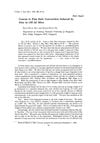TLDR Mineral deposits form in hair follicles after skin injury, faster in rats given DHT.
The study investigated the mineralization of hair follicle tissue in hyperealeaemic rats following skin injury. It was found that mineral deposits, indicated by increased calcium and phosphorus, began forming in hair follicle tissue 6-12 hours after a mild crush injury in rats dosed with dihydrotachysterol (DHT), and 24-48 hours in non-dosed rats. X-ray diffraction showed a diffuse apatite pattern. Additionally, a rise in calcium content was observed within 3 hours of injury, likely due to calcium binding rather than mineral deposition, and was not related to DHT dosing.
12 citations
,
December 1965 in “Immunology and Cell Biology” Mild skin injury can trigger mineral deposits in rat skin, even without full calciphylactic response.
 4 citations
,
January 1992 in “The Tohoku Journal of Experimental Medicine”
4 citations
,
January 1992 in “The Tohoku Journal of Experimental Medicine” Zinc made mice's coarse hair turn into fine hair without affecting skin structure.
January 1992 in “Proceedings of the New Zealand Society of Animal Production” Ferret hair growth starts between 0 and 4 days after melatonin treatment, with cell growth peaking in the hair germ and declining as the hair matures.
18 citations
,
October 1978 in “The journal of investigative dermatology/Journal of investigative dermatology” Excess vitamin A causes lasting gland changes in mouse hair follicles.
9 citations
,
October 1976 in “Journal of Cutaneous Pathology” Human growth hormone treatment improved skin thickness and structure in osteoporosis patients.
6 citations
,
August 1975 in “Journal of Endocrinology” Cortisol and corticosterone thin mouse skin and regress hair follicles, while testosterone promotes skin and hair development.

